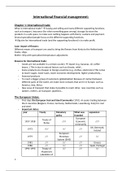International financial management:
Chapter 1: International trade:
What is international trade? buying and selling and many different supporting functions,
such as transport, insurance (for when something goes wrong), storage (to store the
products in a safe space, to make sure nothing happens with them), customs and payment.
Several specialised people focus on the different supporting functions.
Big aim for international trade (and the supporting functions) is to make profit.
Case: import of flowers:
Different means of transport are used to bring the flowers from Kenia to the Netherlands:
trucks, ships.
Reefer: Ship with specialised temperature adjustment.
Reasons for International trade:
- Goods are not available in a certain country import (e.g. bananas, oil, coffee
beans…) This is due to natural factors such as climate, relief…
- Some products are cheaper in foreign countries (e.g. clothes, electronics) This is due
to lower wages, lower taxes, lower economic development, higher productivity…
- Seasonal products
- To reach a bigger group of customers (globalization) Because of contact between
different parts of the world, we make more contacts that aren’t in Europe, such as
America, Asia, Africa
- New ways of transport that make it possible to reach other, new countries such as
tankers, reefers, air transport, pipelines…
The European Union:
- First step: the European Coal and Steel Community (1951) easier trading between
the 6 countries (Belgium, France, Germany, Netherlands, Luxemburg, Italy) for coal
and steel.
- Important dates:
year Treaty Monetary What was expansion
policy founded
European
Treaty of
1957-1958 //// Economic ////
Rome
community
UK, Denmark,
1973 //// /// ///
Ireland
European
1979 /// Monetary /// ///
System (EMS)
1981 /// /// /// Greece
1986 /// /// /// Spain, Portugal
1991-1993 Treaty of /// /// ///
Maastricht
(abelation of
1
, international
borders
European
Union)
Sweden,
1995 /// /// ///
Finland, Austria
Euro-zone (non-
1999 /// /// ///
cash euro)
Introduction of
the euro (bank
2002 /// /// ///
notes and
coins)
10 new
2004
counties
Bulgaria,
2007
Romania
Treaty of
Lisbon
(adjustments
2007-2009
to treaty of
Rome and
Maastricht)
2013 Croatia
Know the members of the European Union by heart (not Euro-zone).
EMS II (European monetary system): Stable exchange rate relative to the euro for members
who aren’t in the Eurozone (only Denmark uses this system).
Trade agreement: an agreement between two or more countries to promote mutual trade
by the total or partial removal of existing trade barriers, examples of these barriers are
tariffs, taxes, quota, embargo quantitative barriers, qualitative barriers (e.g. for food) and
administrative barriers (procedures, documents…).
The European Union tries to get rid of these barriers:
- Treaty of Rome:
Customs Unions
Free movement of goods
Common external tariff (CET) = import duties
Common commercial policy
Common market
Customs unions
Free movement of services and factors of production
Know difference between free trade zone and customs union.
2
, Provenance of a good: last place where goods are dispatched.
Origin of a good: nationality of a good, country where good was produced or where
last relevant economic operation took place.
E.g. silk goes from Laos to China:
Origin: Laos
Provenance: China
Know the members of the EFTA!
- Treaty of Maastricht:
Economic union:
Common market
Harmonized economic policies
Monetary union
Economic union
Harmonized monetary policy
Schengen agreement: free movement of people
- No more checks on movement of persons at international borders (in EU)
- 22 members + 4 EFTA countries
- UK and Ireland aren’t members
Conditions to enter the EU (4 Copenhagen criteria):
1) Stable institution which guarantees democracy, respect of human rights …
2) Functional market economy
3) Agree to all political, economic and monetary objectives of the European Union.
4) Adjust to all administrative structures to integrate in the EU (gradually).
Benefits of being in the EU:
- Stability in Europe
- Increasing the global influence
- Economic growth by market expansion
Decision structure of EU:
- European Council (=council of Ministers) and European parliament:
One minister of each member state.
Votes based on size of population and economic importance of the Member
State.
Takes decisions either unanimously or by a qualified majority (at least 55% of the
votes and should represent 65% of the EU population)
- European Commission:
Executes the European policy
Ensures implementation of the decisions taken by the Council.
28 members (Marianne Thyssen for Belgium)
3




